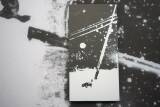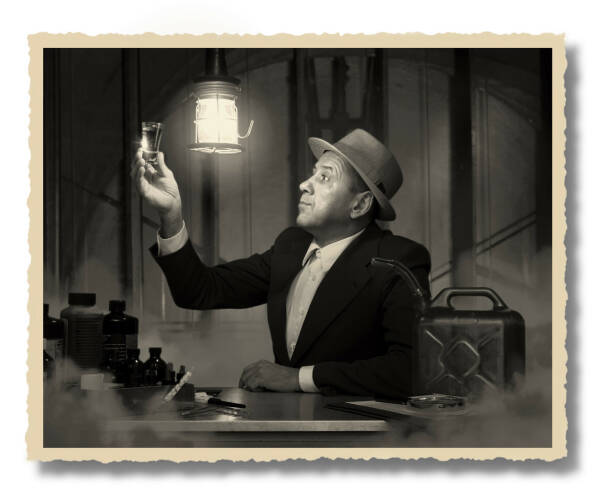Path In Between (signed)
by Hajime Kimura
Photographs: Hajime Kimura
Text: Yumi Goto
Publisher: L'Artiere Collection
104 pages
Year: 2016
ISBN: 978-88-87569-74-2
Comments: Hardcover, 24.5 x 30.5 cm
“The book “PATH IN BETWEEN” is the visual record of the author’s process of recovering memories with clues found on paths his father used to take and places his family used to visit. When he attempted to trace memories of his late father, Hajime Kimura realized that most of them were missing. Because of this, his photos were shot with a half-framed camera. Each image consists of two shots divided by a thick black border. The continuous sequence of the images seems to repeatedly suggest the photographer’s impossible attempt at recovering a lost past. One can come close to faded memories, but cannot reconstruct them perfectly. Kimura almost reaches the essence of his father’s true character–– the man he barely tried to get to know when he was still alive–– but never quite. A mythical father figure emerges through the vague silhouettes of memories that occasionally cross the page.
When we see a diptych combining two completely different shots, we notice that large part of Kimura’s memory is missing. And, because the nature of memory itself is always ambiguous, real memories have occasionally been replaced by desired ones. Time and action accumulate in the past. They turn into a congregation of recollections. Human beings therefore are living with an enormous amount of memories and repeat a process of accumulation all their lives. If a remembrance is used as a clue to recognize our past and our individual existence, then the partial or entire loss of memory is, in a sense, a missed opportunity to recognize who we are. Existence in itself is lost –– our own and the one of the people we love.
Kimura also produced another series depicting his late father titled “Man and Dog.” In the series the “man” is actually his father, but the fact that he did not use the word “father” indicates his prolonged and distant emotions towards him. While his father was still alive, the photographer never took particular notice of the trivial conversations they exchanged with each other, he never closely examined his own view towards him. Ironically, his gaze towards his father became more distant when he became his photographic subject. However, as distant as his gaze might be, Kimura’s observing eye became more intimate. In a way a simple rule seems to unfold: one has to be close to his photographic subjects, but having a strong feeling towards them doesn’t necessarily constitute a successful photographic act. First of all photography is a medium that requires physical distance from a subject. A photographic image is created from this innate conflict, yet can also trigger exquisite emotions in a viewer. This effect is beautifully represented in this book.
In the last two to three years, Kimura seems to have been obsessively creating these series about his father. In this book, the photographer’s act of searching for memories through the act of taking pictures, emerges with a minimal and simple style. It seems as though he is trying to re-live with his father through his idealized and blurred memories, through a never-ending search for something that is almost invisible.”
Yumi Goto
More books by Hajime Kimura
-
Snowflakes Dog Man (signed)
by Hajime Kimura
sold out -
Snowflakes Dog Man (signed - last copy)
by Hajime Kimura
Euro 350 -
Correspondence (signed)
by Hajime Kimura
Euro 70 -
Correspondence (book + print)
by Hajime Kimura
Euro 300
more books tagged »Japanese« | >> see all
-
1973
by Keiichi Tahara
Euro 44 -
Tori
by Yamamoto Masao
sold out -
Humanity
by Kazuto Ishikawa
Euro 54 -
Sense Of Place
by Motohashi Seiichi
Euro 48 -
Birds (last copy)
by Yohei Kichiraku
Euro 49 -
Various Shaped Hoses and Snake (last copy)
by Takashi Homma
sold out
more books tagged »black and white« | >> see all
-
Hartlepool 1960s
by John Bulmer
Euro 60 -
Almost there (last copy)
by Aleix Plademunt
Euro 70 -
KINKY CITY & ARAKIMANIA
by Paweł Jaszczuk & Nobuyoshi Araki
Euro 29 -
I will be wolf
by Bertien van Manen
Euro 39 -
What Was Home
by Dileep Prakash
sold out -
Zine Collection N°19: The Family (signed+print)
by Alain Laboile
sold out
Random selection from the Virtual bookshelf josefchladek.com
Path In Between (signed)
by Hajime Kimura
Photographs: Hajime Kimura
Text: Yumi Goto
Publisher: L'Artiere Collection
104 pages
Year: 2016
ISBN: 978-88-87569-74-2
Comments: Hardcover, 24.5 x 30.5 cm
“The book “PATH IN BETWEEN” is the visual record of the author’s process of recovering memories with clues found on paths his father used to take and places his family used to visit. When he attempted to trace memories of his late father, Hajime Kimura realized that most of them were missing. Because of this, his photos were shot with a half-framed camera. Each image consists of two shots divided by a thick black border. The continuous sequence of the images seems to repeatedly suggest the photographer’s impossible attempt at recovering a lost past. One can come close to faded memories, but cannot reconstruct them perfectly. Kimura almost reaches the essence of his father’s true character–– the man he barely tried to get to know when he was still alive–– but never quite. A mythical father figure emerges through the vague silhouettes of memories that occasionally cross the page.
When we see a diptych combining two completely different shots, we notice that large part of Kimura’s memory is missing. And, because the nature of memory itself is always ambiguous, real memories have occasionally been replaced by desired ones. Time and action accumulate in the past. They turn into a congregation of recollections. Human beings therefore are living with an enormous amount of memories and repeat a process of accumulation all their lives. If a remembrance is used as a clue to recognize our past and our individual existence, then the partial or entire loss of memory is, in a sense, a missed opportunity to recognize who we are. Existence in itself is lost –– our own and the one of the people we love.
Kimura also produced another series depicting his late father titled “Man and Dog.” In the series the “man” is actually his father, but the fact that he did not use the word “father” indicates his prolonged and distant emotions towards him. While his father was still alive, the photographer never took particular notice of the trivial conversations they exchanged with each other, he never closely examined his own view towards him. Ironically, his gaze towards his father became more distant when he became his photographic subject. However, as distant as his gaze might be, Kimura’s observing eye became more intimate. In a way a simple rule seems to unfold: one has to be close to his photographic subjects, but having a strong feeling towards them doesn’t necessarily constitute a successful photographic act. First of all photography is a medium that requires physical distance from a subject. A photographic image is created from this innate conflict, yet can also trigger exquisite emotions in a viewer. This effect is beautifully represented in this book.
In the last two to three years, Kimura seems to have been obsessively creating these series about his father. In this book, the photographer’s act of searching for memories through the act of taking pictures, emerges with a minimal and simple style. It seems as though he is trying to re-live with his father through his idealized and blurred memories, through a never-ending search for something that is almost invisible.”
Yumi Goto
More books by Hajime Kimura
-
Snowflakes Dog Man (signed)
by Hajime Kimura
sold out -
Snowflakes Dog Man (signed - last copy)
by Hajime Kimura
Euro 350 -
Correspondence (signed)
by Hajime Kimura
Euro 70 -
Correspondence (book + print)
by Hajime Kimura
Euro 300
more books tagged »Japanese« | >> see all
-
1973
by Keiichi Tahara
Euro 44 -
Tori
by Yamamoto Masao
sold out -
Humanity
by Kazuto Ishikawa
Euro 54 -
Sense Of Place
by Motohashi Seiichi
Euro 48 -
Birds (last copy)
by Yohei Kichiraku
Euro 49 -
Various Shaped Hoses and Snake (last copy)
by Takashi Homma
sold out
more books tagged »black and white« | >> see all
-
Hartlepool 1960s
by John Bulmer
Euro 60 -
Almost there (last copy)
by Aleix Plademunt
Euro 70 -
KINKY CITY & ARAKIMANIA
by Paweł Jaszczuk & Nobuyoshi Araki
Euro 29 -
I will be wolf
by Bertien van Manen
Euro 39 -
What Was Home
by Dileep Prakash
sold out -
Zine Collection N°19: The Family (signed+print)
by Alain Laboile
sold out
Random selection from the Virtual bookshelf josefchladek.com
Path In Between (signed)
by Hajime Kimura
Photographs: Hajime Kimura
Text: Yumi Goto
Publisher: L'Artiere Collection
104 pages
Year: 2016
ISBN: 978-88-87569-74-2
Comments: Hardcover, 24.5 x 30.5 cm
“The book “PATH IN BETWEEN” is the visual record of the author’s process of recovering memories with clues found on paths his father used to take and places his family used to visit. When he attempted to trace memories of his late father, Hajime Kimura realized that most of them were missing. Because of this, his photos were shot with a half-framed camera. Each image consists of two shots divided by a thick black border. The continuous sequence of the images seems to repeatedly suggest the photographer’s impossible attempt at recovering a lost past. One can come close to faded memories, but cannot reconstruct them perfectly. Kimura almost reaches the essence of his father’s true character–– the man he barely tried to get to know when he was still alive–– but never quite. A mythical father figure emerges through the vague silhouettes of memories that occasionally cross the page.
When we see a diptych combining two completely different shots, we notice that large part of Kimura’s memory is missing. And, because the nature of memory itself is always ambiguous, real memories have occasionally been replaced by desired ones. Time and action accumulate in the past. They turn into a congregation of recollections. Human beings therefore are living with an enormous amount of memories and repeat a process of accumulation all their lives. If a remembrance is used as a clue to recognize our past and our individual existence, then the partial or entire loss of memory is, in a sense, a missed opportunity to recognize who we are. Existence in itself is lost –– our own and the one of the people we love.
Kimura also produced another series depicting his late father titled “Man and Dog.” In the series the “man” is actually his father, but the fact that he did not use the word “father” indicates his prolonged and distant emotions towards him. While his father was still alive, the photographer never took particular notice of the trivial conversations they exchanged with each other, he never closely examined his own view towards him. Ironically, his gaze towards his father became more distant when he became his photographic subject. However, as distant as his gaze might be, Kimura’s observing eye became more intimate. In a way a simple rule seems to unfold: one has to be close to his photographic subjects, but having a strong feeling towards them doesn’t necessarily constitute a successful photographic act. First of all photography is a medium that requires physical distance from a subject. A photographic image is created from this innate conflict, yet can also trigger exquisite emotions in a viewer. This effect is beautifully represented in this book.
In the last two to three years, Kimura seems to have been obsessively creating these series about his father. In this book, the photographer’s act of searching for memories through the act of taking pictures, emerges with a minimal and simple style. It seems as though he is trying to re-live with his father through his idealized and blurred memories, through a never-ending search for something that is almost invisible.”
Yumi Goto
More books by Hajime Kimura
-
Snowflakes Dog Man (signed)
by Hajime Kimura
sold out -
Snowflakes Dog Man (signed - last copy)
by Hajime Kimura
Euro 350 -
Correspondence (signed)
by Hajime Kimura
Euro 70 -
Correspondence (book + print)
by Hajime Kimura
Euro 300
more books tagged »Japanese« | >> see all
-
1973
by Keiichi Tahara
Euro 44 -
Tori
by Yamamoto Masao
sold out -
Humanity
by Kazuto Ishikawa
Euro 54 -
Sense Of Place
by Motohashi Seiichi
Euro 48 -
Birds (last copy)
by Yohei Kichiraku
Euro 49 -
Various Shaped Hoses and Snake (last copy)
by Takashi Homma
sold out
more books tagged »black and white« | >> see all
-
Hartlepool 1960s
by John Bulmer
Euro 60 -
Almost there (last copy)
by Aleix Plademunt
Euro 70 -
KINKY CITY & ARAKIMANIA
by Paweł Jaszczuk & Nobuyoshi Araki
Euro 29 -
I will be wolf
by Bertien van Manen
Euro 39 -
What Was Home
by Dileep Prakash
sold out -
Zine Collection N°19: The Family (signed+print)
by Alain Laboile
sold out
Random selection from the Virtual bookshelf josefchladek.com





























;jpg?c=a8b4058f71c86b1b489d9c6b418c3d8d)




;jpg?c=f61c0e4cf5340d48c2019e97af25547c)
_;jpg?c=419d59e36ac6254ab2ee57eb072962ae)
;jpg?c=f2bd9db58f7a0d5189be2c705309b243)